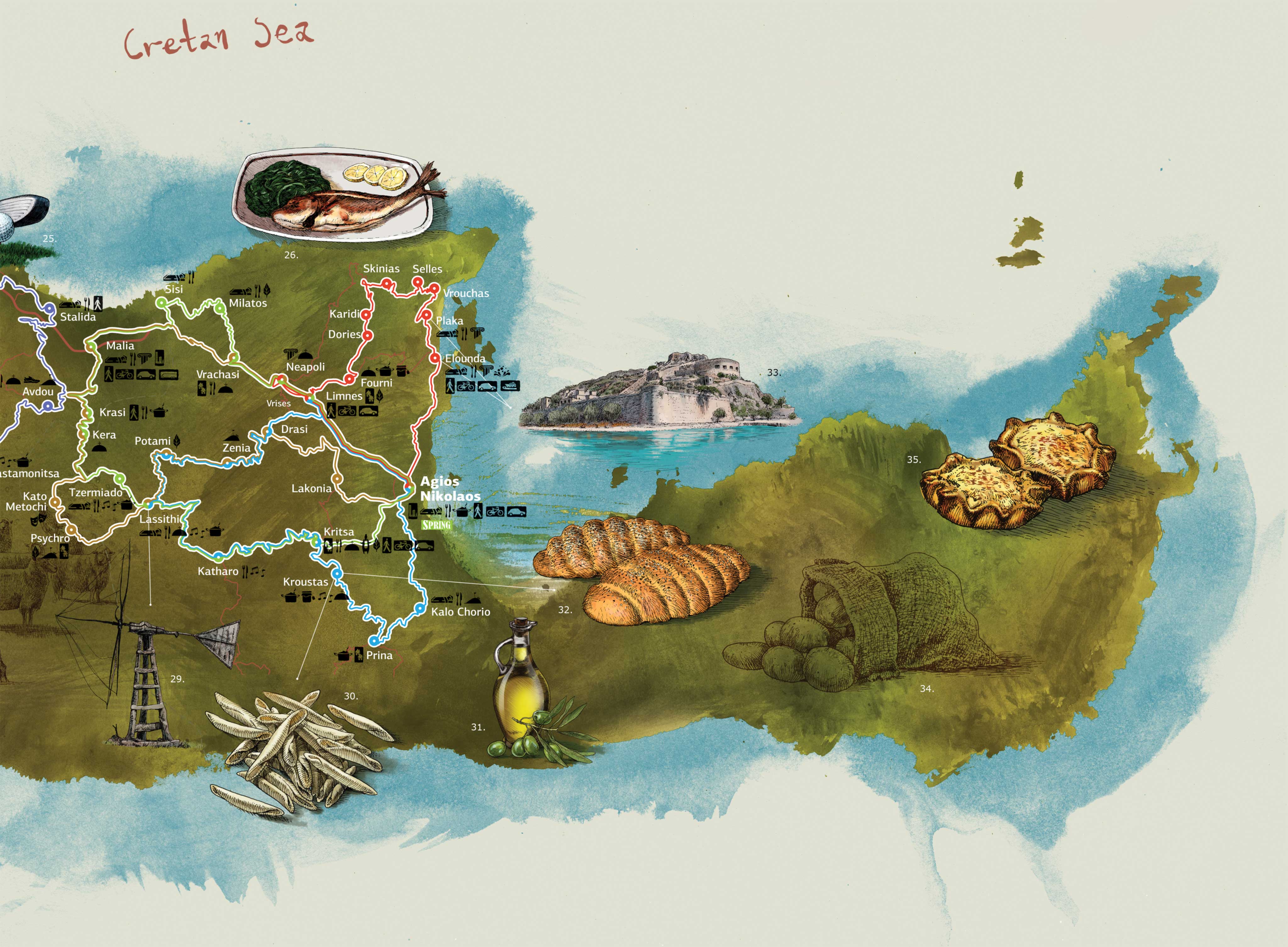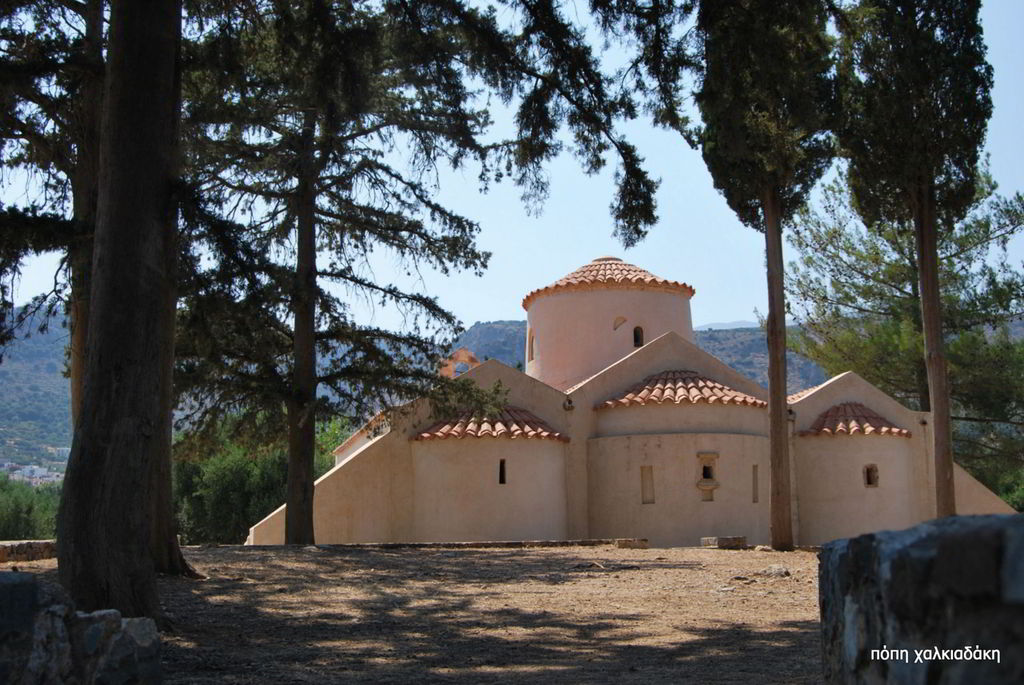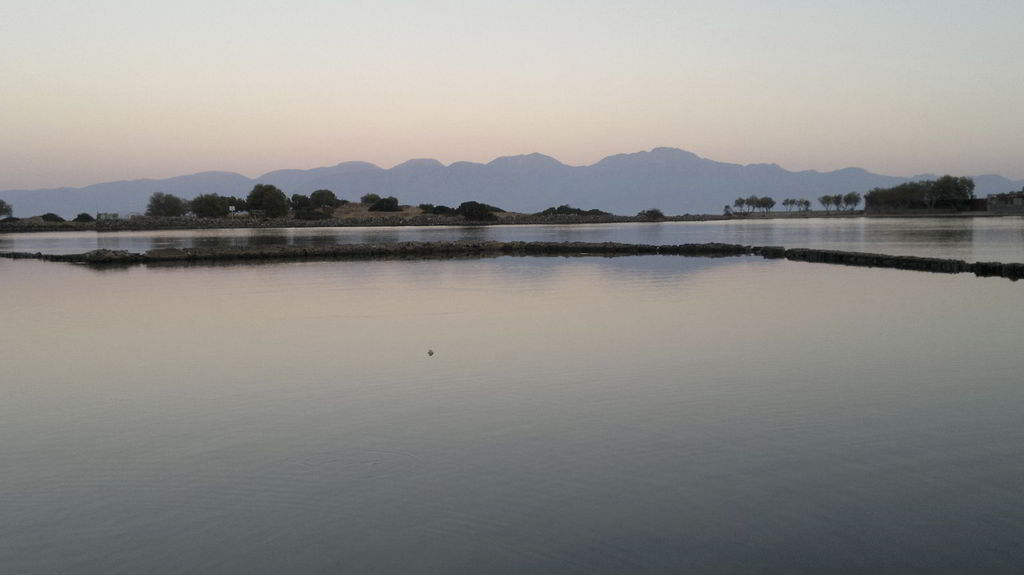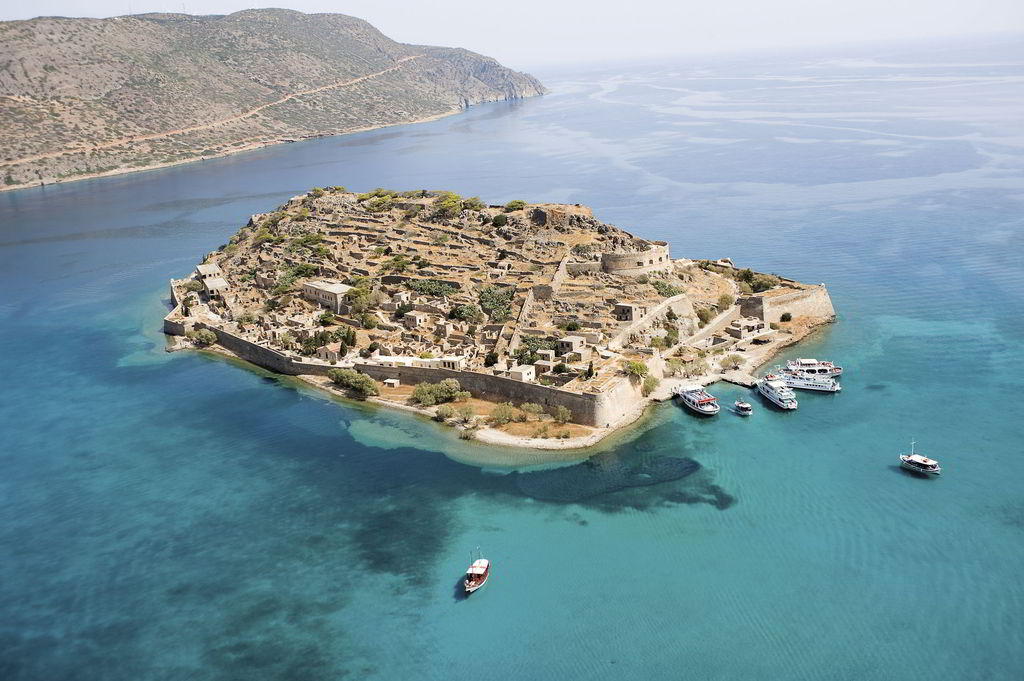



- Route 1
- Route 2
- Route 3
- Route 4
- Route 5
- Route 6
- Route 7
- Route 8
- Route 9
- Route 10
- Road
- Region Boundaries
- Accommodation
- Gastronomic Centre Restaurants-Taverns
- Winemakers
- Campsite
- Thermal springs & Spa Centres
- City
- Village
- History and Culture
- Folklore Cultural Events
- Country
- Sports & Recreation
- Ski resorts
- Tour guide needed
- Archaeological Sites & Monuments
- Natural Environment
- Church
- Female Cooperatives
- Plants local delicacies
- Local Products & Recipes
- By Foot
- By Car
- By Bicycle
- By Bus
- Port
- Railway Station
- Airport
- Seniors
- Families
- Youth
- The whole year
- Best Month
- Best Season
Lassithi welcomes visitors by impressing them with its unparalleled natural beauty.
It is a place of sharp contrasts, entangled in a timeless play of the earth, the sea and the air.
Unique archaeological sites, breathtaking ravines and caves, magnificent plateaus, ancient paths, cultural and nature-lovers’ routes, picturesque little villages. Its sea world invites you to experience utter mystery and beauty. Beautiful beaches and small fishing villages, with a deep sense of respect for the sea.
Human warmth, peace, hospitality and ancient traditions that still flourish in the hearts of the people, expressed through the local cultural events and Cretan cuisine. Authentic tastes and fragrances, unique culinary experiences using high-quality local products and recipes that have been handed down from generation to generation.
ROUTES
Sea breeze and cool
The starting point of this route is the city of Ágios Nikólaos. Take the North Road Axis of Crete (VOAK) southbound, and go up to Ammoudára and Vathý, where you may stop for a swim in their majestic beaches, while it is worth your time to visit the wetland of Almyrós (right after the town).
At a distance of 12 km from Ágios Nikólaos you will come across Kaló Chorió, where you may find hotels and apartments to let, giving you a chance to eat and rest.
There are beautiful beaches to swim at: you may choose among Karavostási, Ágios Panteleímonas (an ideal beach for windsurfing aficionados), Voúlisma (perfect for families with young children). Right after the village entrance, turn right to the Kaló Chorió - Metaxochóri provincial road.
After 6 km, you will reach the village of Prína, renowned for its fragrant honey. Make a stop, have a taste and you are certain to buy some, as it is truly one of a kind!
From here you will take the Ágios Nikólaos - Prína provincial road uphill, which will take you after approximately 25 minutes to Kroústas where a stop is in order for a stroll around the village. Going downhill towards Ágios Nikólaos, in just under 4 km, you will come across the beautiful - unique, even - village of Kritsá.
Many interesting points that you should not miss during your stay in the village is a visit to the churches that are monuments of high interest, “Panagia Kera” as it is the reference point for thousands of visitors.
Nearby, just 3 km after, there is the ancient Lato, one of the most famous and best preserved ancient cities of Crete.
In the village there are several restaurants where you can taste the flavors of Lassithi with the multiple award winning premium quality olive Kritsa. If you wish to learn more about olive oil, you have only to visit the agricultural cooperative.
Before leaving the village drop by the workshop of women’s cooperative to watch the preparation of traditional sweets such as “xirotigana” and cheese pies, but mainly to try.
If you love nature and adventure, you can cross the gorge of Kritsa.
From Kritsá you will go uphill and to the west, heading towards Katharó - truly a place like no other - with just a few houses and a handful of tavernas serving mainly local products.
Don’t forget to sample the local cuisine: oftó baby goat or lamb and fresh myzíthra cheese, produced by the herdsmen of Katharó. In wintertime they are only open on weekends.
If you are true nature lovers, you may take an excursion up to the Katharó Plateau, where you may see the rich variety of excavated midget hippopotamus bone fossils.
Leaving Katharó behind, head west and tread carefully towards the Lassíthi Plateau, and particularly the Méssa Lassíthi, that used to be renowned for its red sour apples that were transported to the Sultan in Constantinople.
Make a stop at Moní Kroustallénia, the religious centre of Lassíthi. Turn right and follow the Oropédio - Ágios Nikólaos provincial road. In approximately ten minutes, you will come across Potámi, literally buried in greenery. Make a stop to rest and admire the scenery.
Visit Panayía and let beauty sink in. Icy cold water wells, local products on the tables, tavernas, resting in the shade - or all of the above combined - will make you feel simply wonderful.
From this point onwards, the route goes downhill and crosses Zénia, where you may visit the ruins of an ancient city, as well as Atziganóspilios, one of the most notable caves in the prefecture of Lassíthi. Right after that, you pass by the settlements of Áno Amygdáli, Amygdáli and Drási to head northbound and reach Vrýsses, a beautiful village overlooking the Neápolis plains.
A bit further down the road, you will come across Moní Kremastón; it is really worthwhile to make a stop.
Going downhill, you pass by the beautiful villages of Choumeriáko and Nikithianó to reach Límnes, one of the best-preserved villages located in the shade of ancient Dríros.
The route from Límnes takes an eastbound direction and after 10 km on either the old or the new national road, you come to Ágios Nikólaos -the end.
If you still have time left, you should definitely take a stroll by the lake and visit the Ágios Nikólaos Archaeological Museum, as well as the Folklore Museum that is housed in the ground floor of the old Port Authority building by the lake bridge.
The stone roads
The route starts from the city of Ágios Nikólaos and takes the Ágios Nikólaos - Elounda provincial road, and after approximately 10km leads you to Elounda, the world famous tourist resort that sports luxury hotels, countless tavernas, restaurants, traditional cafés, recreational areas and a natural landscape of incomparable beauty.
Heading east and leaving the channel behind, take the dirt road and go downhill on foot to reach the beach of Kolokýtha with its green-blue waters; it is the destination of thousands of visitors. From Eloúnda go north and after 5km by the sea, you will reach the traditional fishing village of Pláka, where you shouldn’t miss the chance to stop for food: fresh fish is on the menu. Don’t forget to visit Spinalonga on a small boat either from Eloúnda or from Pláka. It is a visit that is definitely worth your while in more ways than one.
For those who want to dedicate time to yourself can enjoy spa services, and if you love golf, you also have the opportunity to practice your hobby into a small eight-hole golf hotel in the area. In the taverns will find traditional Cretan dishes and fresh fish cooked in a special way. Remember that in July organized seafood nights with plenty of fish at the tables and the wine and “Raki” in abundance.
Going uphill and after a short while you will come across the settlement of Vrouchás and within less than 5km you will reach the next settlement, that of Sélles, where you should definitely see the renovated factory (an old oil press). Carry on and go through the settlements of Káto Loúma and Epáno Loúma, where you may see windmills, old oil presses and cisterns.
Our next stop is Skiniás with its cobblestone beaches in Vlichádia and Ágios Antónios “Sfouggarás” -ideal for swimming and fishing.
The route continues westbound to Neápoli, while before Karýdi you should stop and visit Moní Aretíou, the famous monastery that resembles a small fortified town. The tour will take you to an oil press, a wine press and a creamery. Going straight from Karýdi, you will come up to Doriés with the monastery of Ágios Konstantínos and Eléni that sports important works of high religious and artistic value. Moving on southbound, you will overlook Fourní. At the right turn, below the road, you are bound to be awestricken by the impressive mylótopos of Crete, with 13 mills in a row.
A visit to Agía Ánna, Moní Kerapolítissas, Moní Kerámou and the small folklore museum is an absolute must. The route continues southbound and at a distance of approximately 5km, you will go pass the village of Nikithianó, where you may see old windmills and then carry on towards Neápoli with its old manors, the picturesque alleyways, the ottoman fountains, the municipal garden and the central square with the Great church. Don’t forget to visit the Folklore Museum and the Neápoli archaeological collection, the house of Roússos Koúndouros, as well as the archaeological site of Dríros at a mere 2km east of Neápoli.
Ask to be served soumáda, the local refreshment, browse the local shops for thyme honey, amygdalotá, dairy products, rakí and wine. The tavernas and rakí shops are all gathered around the square, where you will taste food and mezés of incomparable quality. Go back to Nikithianó and from there take the old Ágios Nikólaos - Heráklion national road to Ágios Nikólaos, the route’s end point.
Mountain Tour
The starting point of this route is the city of Ágios Nikólaos. Take the Ágios Nikólaos - Kritsá provincial road, and after approximately 10km you will come to the beautiful - unique, even - village of Kritsá (connection with Route 7). After reaching Kritsá, you have two options (Routes 9.1 and 9.2) to cross the Lassíthi Plateau:
3.a. The route continues (driving slowly and carefully) towards the Lassíthi Plateau and more precisely Mésa Lassíthi, so keep to the right in order to cross Marmakéto and reach Tzermiádo, the largest village in the Lassíthi Plateau, where we propose that you make a stop at the Agía Triáda parish church and the relic museum right next to it.
Don’t forget to visit the important Trapéza cavern, also known as Krónion and the Níssimos Plateau. Continue on a westward course, cross the settlements of Lagós and Pinakianó and then go downhill; in approximately 5 km you will come to Kerá.
3.b After passing Kritsá, head towards Lakónia. After crossing the settlements of Amýgdala, you will come to the village of Zénia. At a small distance from the village, you may visit the ruins of an ancient city, as well as Atziganóspilios, one of the most noteworthy caverns of Lassíthi that you really shouldn’t pass on the opportunity to see. Going uphill, you shall pass by Potámi (Mésa Potámi and Éxo Potámi), two villages built in the middle of verdant vegetation, both of exquisite beauty and fascinating history. Continuing your route, you come to the Lassíthi Plateau and make your first stop at Mésa Lassíthi; a short distance further, you will come to Moní Kroustallénia and then turn left towards Ágios Konstantínos, Ágios Geórgios and Avrakónte.
All the villages that you will come across on the Plateau are of unique beauty and you may visit them throughout the year. Stop wherever it suits your fancy, strike up a conversation with the locals, have a rakí with oftí potato on the side and buy local products (apples, pears, beans, potatoes, etc.).
From Avrakónte you go uphill to the majestic plateau of Limnákaros, from where the main hiking path starts, leading all the way up to the top of mount Aféndis. Our next stop is Psychró, an attractive village with a lot of water and an icy-cold fresh water fountain on the street.
You shouldn’t leave before visiting the world-renowned since ancient times worship cave of Diktéo Ándro that attracts thousands of visitors every year; according to ancient Greek tradition, this is the birthplace of Zeus, the father of all Olympian Gods and his main place of worship. You may approach the cave by foot or by donkey on the well-maintained path.
The route carries on by going through the settlements of Ágios Charálampos and Káto Metóchi, where just outside the village you should make a stop at the restored Moní Vidianís, where you may also visit their small museum of natural history.
As your trip around the Plateau nears its end, you may turn left and, after a stop at Selí Ampélou, enjoy the view of the sea.
Start making your way downhill and in approximately 5km you will come to Kerá with its breathtaking view overlooking the Avdós valley. You may stop at the historical Moní Kardiótissas to admire the impressive byzantine hagiographies.
Don’t forget to taste the unparalleled roast meat at the village’s tavernas, prepared in wood-burning stoves.
The route goes downhill to meet, with a detour to the right, the picturesque village of Krássi, where it is truly worthwhile to take a stroll down its streets and definitely have a coffee underneath the enormous monumental platanus tree that many a time lent its shade to the artistic genius of the great Cretan thinker Níkos Kazantzákis.
Leaving Krássi behind and after approximately 10km of exquisite view and unique natural surroundings, you will come to the tourist resort of Mália, where you definitely must visit the Mália complex of palaces, built according to the Knossós and Festós architectural style, at a distance of no more than 3km to the east of the settlement. Leaving Mália, follow the old Heráklion - Ágios Nikólaos national road and turn left at the signs to make a stop at Sísi, a picturesque little local fishing village or move just a bit further to the east towards yet another fishing village, Mílatos with many fish tavernas and ample accommodation.
At a nearby distance (3km), south-east bound, you will come to the historical Cave of Mílatos, where in 1823 about 200 Christians were martyred. Going uphill and making a small detour to the right, you will reach the most special and picturesque village of Vrachássi, where a brief tour around the settlement is a must. Continue on a south-eastern and cross the small settlement of Latsída (quite famous over the past years for its succulent souvláki). Our next stop is the city of Neápoli (connection with Route 8) and the route ends with your return to Ágios Nikólaos.
Mountain Tour
The starting point of this route is the city of Ágios Nikólaos. Take the Ágios Nikólaos - Kritsá provincial road, and after approximately 10km you will come to the beautiful - unique, even - village of Kritsá (connection with Route 7). After reaching Kritsá, you have two options (Routes 9.1 and 9.2) to cross the Lassíthi Plateau:
3.a. The route continues (driving slowly and carefully) towards the Lassíthi Plateau and more precisely Mésa Lassíthi, so keep to the right in order to cross Marmakéto and reach Tzermiádo, the largest village in the Lassíthi Plateau, where we propose that you make a stop at the Agía Triáda parish church and the relic museum right next to it.
Don’t forget to visit the important Trapéza cavern, also known as Krónion and the Níssimos Plateau. Continue on a westward course, cross the settlements of Lagós and Pinakianó and then go downhill; in approximately 5 km you will come to Kerá.
3.b After passing Kritsá, head towards Lakónia. After crossing the settlements of Amýgdala, you will come to the village of Zénia. At a small distance from the village, you may visit the ruins of an ancient city, as well as Atziganóspilios, one of the most noteworthy caverns of Lassíthi that you really shouldn’t pass on the opportunity to see. Going uphill, you shall pass by Potámi (Mésa Potámi and Éxo Potámi), two villages built in the middle of verdant vegetation, both of exquisite beauty and fascinating history. Continuing your route, you come to the Lassíthi Plateau and make your first stop at Mésa Lassíthi; a short distance further, you will come to Moní Kroustallénia and then turn left towards Ágios Konstantínos, Ágios Geórgios and Avrakónte.
All the villages that you will come across on the Plateau are of unique beauty and you may visit them throughout the year. Stop wherever it suits your fancy, strike up a conversation with the locals, have a rakí with oftí potato on the side and buy local products (apples, pears, beans, potatoes, etc.).
From Avrakónte you go uphill to the majestic plateau of Limnákaros, from where the main hiking path starts, leading all the way up to the top of mount Aféndis. Our next stop is Psychró, an attractive village with a lot of water and an icy-cold fresh water fountain on the street.
You shouldn’t leave before visiting the world-renowned since ancient times worship cave of Diktéo Ándro that attracts thousands of visitors every year; according to ancient Greek tradition, this is the birthplace of Zeus, the father of all Olympian Gods and his main place of worship. You may approach the cave by foot or by donkey on the well-maintained path.
The route carries on by going through the settlements of Ágios Charálampos and Káto Metóchi, where just outside the village you should make a stop at the restored Moní Vidianís, where you may also visit their small museum of natural history.
As your trip around the Plateau nears its end, you may turn left and, after a stop at Selí Ampélou, enjoy the view of the sea.
Start making your way downhill and in approximately 5km you will come to Kerá with its breathtaking view overlooking the Avdós valley. You may stop at the historical Moní Kardiótissas to admire the impressive byzantine hagiographies.
Don’t forget to taste the unparalleled roast meat at the village’s tavernas, prepared in wood-burning stoves.
The route goes downhill to meet, with a detour to the right, the picturesque village of Krássi, where it is truly worthwhile to take a stroll down its streets and definitely have a coffee underneath the enormous monumental platanus tree that many a time lent its shade to the artistic genius of the great Cretan thinker Níkos Kazantzákis.
Leaving Krássi behind and after approximately 10km of exquisite view and unique natural surroundings, you will come to the tourist resort of Mália, where you definitely must visit the Mália complex of palaces, built according to the Knossós and Festós architectural style, at a distance of no more than 3km to the east of the settlement. Leaving Mália, follow the old Heráklion - Ágios Nikólaos national road and turn left at the signs to make a stop at Sísi, a picturesque little local fishing village or move just a bit further to the east towards yet another fishing village, Mílatos with many fish tavernas and ample accommodation.
At a nearby distance (3km), south-east bound, you will come to the historical Cave of Mílatos, where in 1823 about 200 Christians were martyred. Going uphill and making a small detour to the right, you will reach the most special and picturesque village of Vrachássi, where a brief tour around the settlement is a must. Continue on a south-eastern and cross the small settlement of Latsída (quite famous over the past years for its succulent souvláki). Our next stop is the city of Neápoli (connection with Route 8) and the route ends with your return to Ágios Nikólaos.




